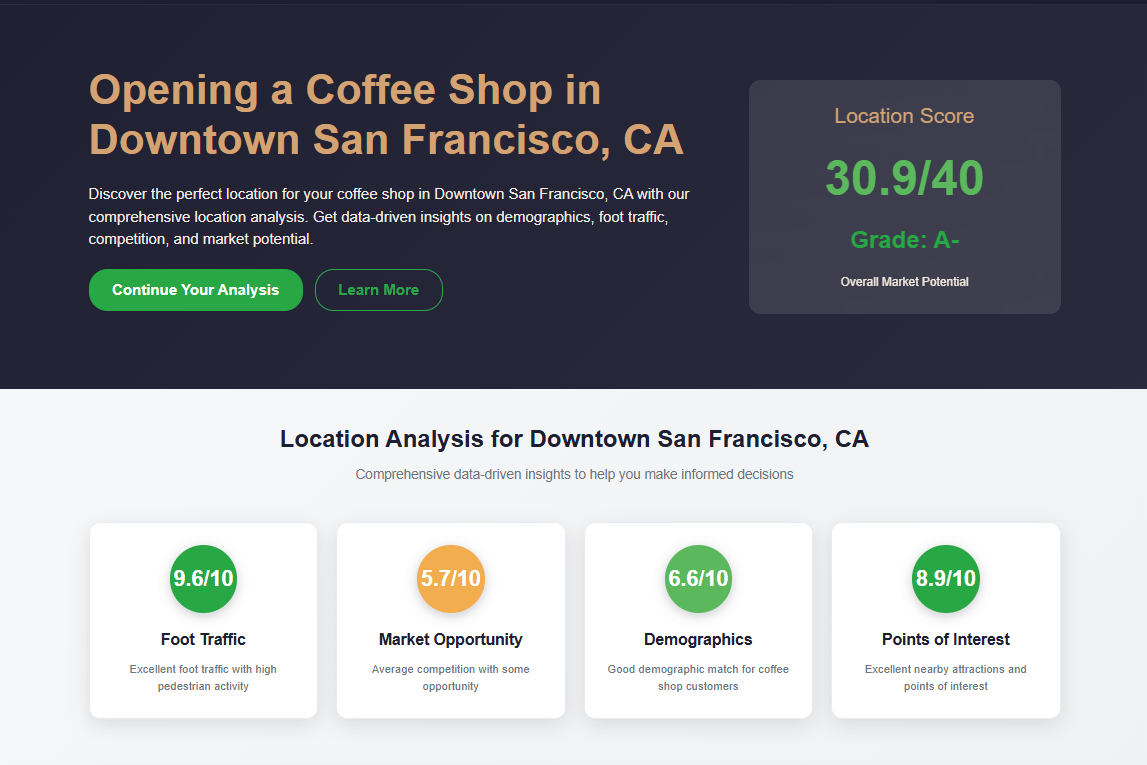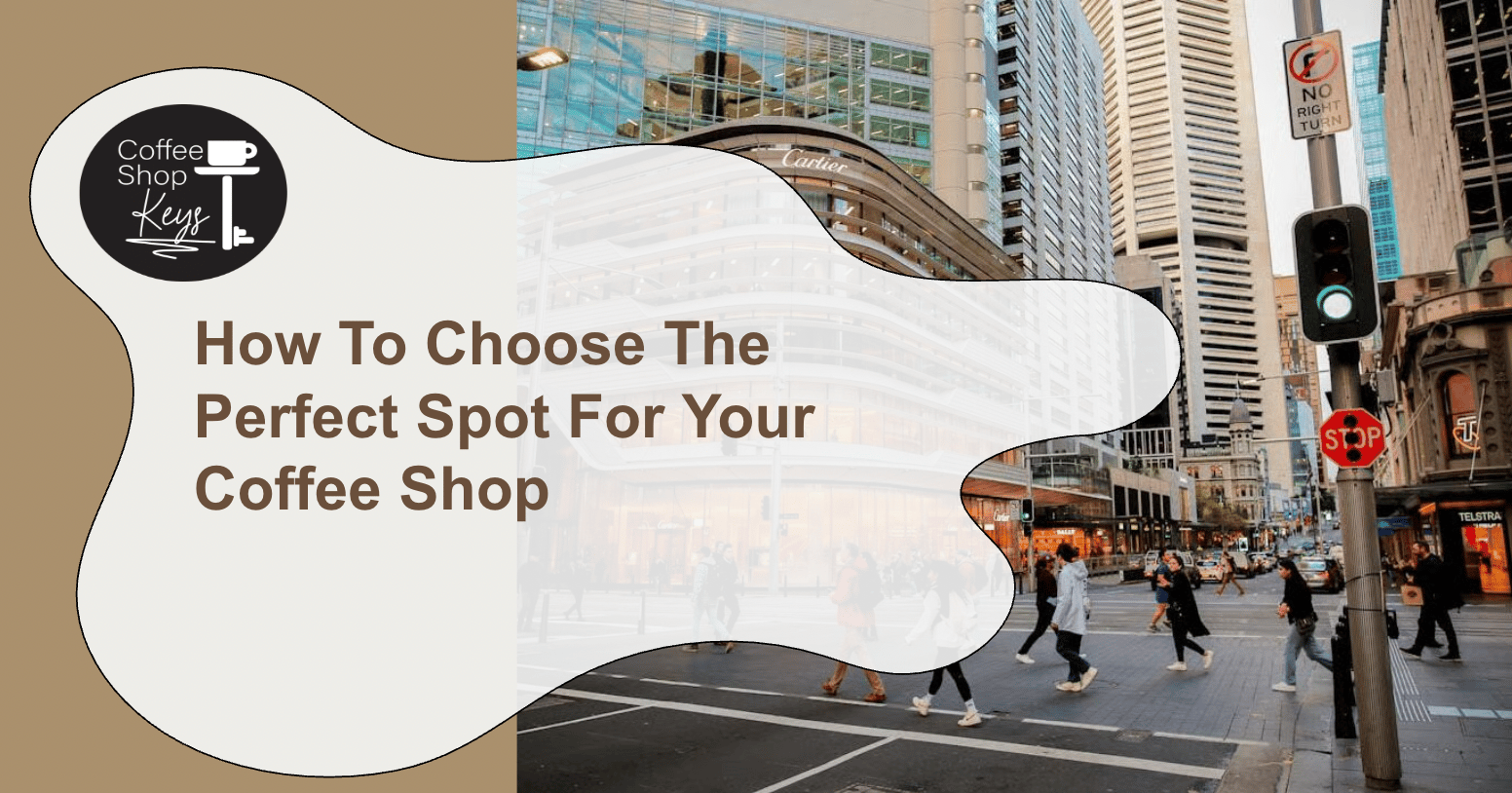Good morning, y’all!
Whether you’re still dreaming about opening your first coffee shop or ready to grow your caffeine empire, it’s easy to get lost in all the details — equipment, branding, menu design, hiring, permits… the list goes on. But before you dive too deep into espresso machines or interior paint swatches, there’s one decision that’ll shape everything else.
Location.
The right spot determines your audience, your hours, your profits, and even your shop’s identity. In this issue, we’ll walk through the most important factors to consider when choosing a location — from demographics to foot traffic to rent — and share a smart way to evaluate all those factors objectively when you’re ready to compare sites.
Table of Contents
Demographics
Before falling in love with a building, take a hard look at who lives, works, and passes through the area. Your target population should align with your coffee shop’s concept and pricing.
Target population match: Are you appealing to college students, commuters, or families? A bustling college town might respond to affordable drinks, flexible seating, and late-night hours. A suburban area filled with young families may prefer a cozy, kid-friendly space. Commuters want quick service and grab-and-go options.
Income and lifestyle data: Use publicly available demographic data to learn about income levels, median age, and spending habits. This helps you estimate what customers are willing to pay and how often they’ll come in.
Daily rhythm and open hours: Office-heavy districts see peak demand on weekday mornings, but foot traffic can drop off after lunch. Mixed-use or residential areas tend to generate steadier business throughout the day and on weekends.
Cultural fit: The personality of your shop should complement the neighborhood vibe. A minimalist, third-wave coffee bar may shine downtown but feel out of place in a quiet, family suburb. Conversely, a cozy community café with comfortable seating and pastries might be perfect for a small-town main street.
Getting this alignment right creates an instant sense of belonging — the feeling that your shop fits the area and the people in it.
Foot Traffic and Visibility
No matter how good your espresso is, customers can’t visit a shop they don’t see. Foot traffic and visibility determine how easy it is for people to discover you — and how often they’ll come back.
Nearby points of attraction: Locations near complementary businesses (like bookstores, gyms, coworking spaces, or bakeries) naturally drive more visitors. A gym-goer grabbing a post-workout latte or a remote worker settling in for the afternoon can quickly become loyal regulars.
Pedestrian volume: Observe the area at different times of day and week. Is there a nearby university, hospital, or office complex generating steady flow? Transit hubs and intersections bring reliable traffic.
Corner or intersection locations: Corner lots tend to have double the visibility, with more window space and signage exposure. They also make for natural gathering spots.
A spot with strong foot traffic may come at a higher rent, but the trade-off often pays for itself through consistent customer flow.

Competition
Every great coffee scene has a little competition — and that’s not always a bad thing.
Nearby cafés can indicate healthy demand for coffee in the area, proving there’s a customer base to tap into. The key is understanding your niche: what will make your shop stand out?
Are you offering a faster, more convenient experience in an area full of sit-down cafés?
A community-driven space where others feel impersonal?
Specialty drinks or unique offerings that local competitors don’t serve?
Mapping competitors within a few blocks can reveal gaps in the market. Sometimes, being near a major chain like Starbucks actually helps — it brings people to the area, while your unique brand captures those seeking a more personal experience.
Space
Your space affects everything — your flow, your vibe, and how efficiently you can work behind the bar. Once you’ve found an area that feels right, take a closer look at whether the space itself aligns with your vision.
Square footage: Make sure it fits your setup — bar, seating, back-of-house, restrooms, and storage. You’ll also need enough room for ADA compliance and smooth traffic flow.
Ambiance: The bones of a building matter. Natural light, ceiling height, and architectural character can make your design choices easier (and often cheaper).
Outdoor seating: Patios or sidewalk cafés aren’t just nice to have — they’re built-in visibility tools that draw in passersby and make your space feel inviting.
And before signing anything, check the building infrastructure — this is where surprises can get expensive:
Plumbing: You’ll need strong water pressure and drainage for espresso machines and sinks.
Electrical: Coffee equipment uses a lot of power — confirm the wiring can handle it.
Ventilation and HVAC: Proper airflow keeps things comfortable (and code-compliant).
Condition: Older buildings can be charming but may require upgrades to meet café standards.

Rent, Zoning, and Profitability
Even the dreamiest space can turn into a headache if the numbers don’t make sense.
Rent-to-revenue ratio: Ideally, your rent should be 6–10% of gross monthly revenue. Below 6% is excellent, giving you plenty of room for other expenses. Above 10% can work in high-traffic or premium locations — for example, near busy transit hubs, downtown districts, or popular tourist areas — but it’s riskier and usually requires strong sales to stay profitable. (And don’t forget to factor in utilities, insurance, and shared area fees)
Zoning and permits: Confirm that the building is zoned for food and beverage service. Some areas have restrictions on ventilation, waste disposal, or outdoor seating that can complicate café operations.
Lease terms: Negotiate for flexibility — such as the ability to expand, renew, or exit early if necessary.
Before signing anything, estimate how long it would take to break even. Factor in build-out costs, equipment, and staffing.
Other Considerations
Once you’ve nailed the basics, a few extra details can make a big difference in your daily operations and customer experience.
Parking: Even if you expect mostly walk-ins, a few convenient spots go a long way. A bigger lot may be necessary in areas with less foot traffic.
Handicap accessibility: Make sure your entrance, restrooms, and layout meet ADA standards.
Neighborhood growth: Check for new housing, offices, or developments that could bring future business.
Safety and lighting: Customers should feel comfortable visiting early in the morning or later at night.
Outdoor environment: Trees, sunlight, and shade help shape the overall vibe.
Hiring pool: Are there enough potential baristas, bakers, and managers nearby?
Deliveries and waste: Make sure there’s easy access for suppliers and trash pickup.
Our Secret Tool 🤫
Choosing the perfect location can feel like juggling a dozen moving pieces at once. That’s where Coffee Shop Kickstarter comes in. It gathers neighborhood demographics, competition, foot traffic, and other key factors to give your potential site a clear, data-backed grade.
There are now free location analysis demos available for dozens of neighborhoods in major cities like Austin, Chicago, Denver, Phoenix, and San Francisco so you can get a feel for the tool before committing. The paid version lets you dive deeper and analyze specific addresses, giving you a precise, customized assessment for your exact potential location.
Think of it as a tool to help you cut through the guesswork and make confident decisions about where to open your next coffee shop — so you can focus on what you love: crafting great coffee and creating a welcoming space.

In the End, It’s About Fit
The perfect coffee shop location balances numbers and nuance — data-driven insight blended with a gut feeling about where your shop belongs.
Walk the area at different times, talk to locals, and imagine the daily rhythm of your future customers. The right spot won’t just serve coffee — it’ll serve the community.
And when you find that place where your brand, your audience, and your surroundings all click? That’s when your coffee shop truly comes to life.
Take care and do good!
✌️,
Coffee Shop Keys


